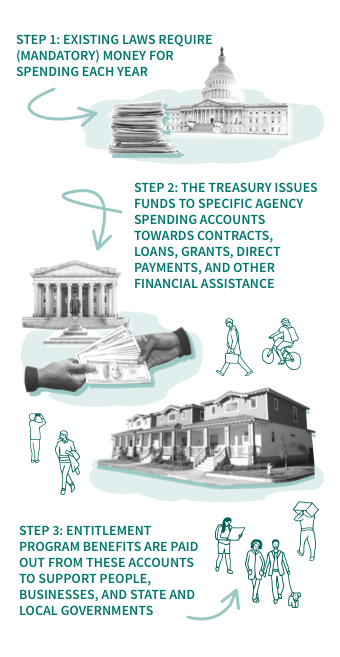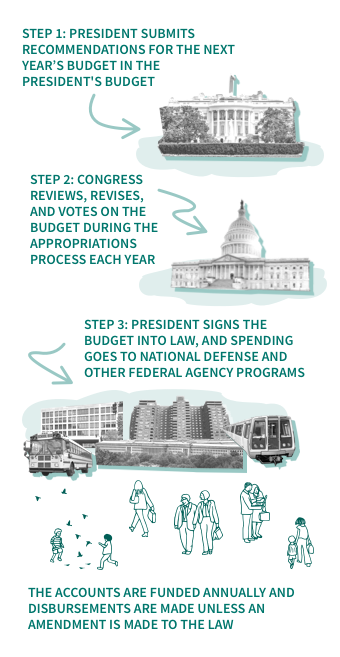
How much has the U.S. government spent this year?
The U.S. government has spent $NaN million in fiscal year to ensure the well-being of the people of the United States.
Fiscal year-to-date (since October ) total updated monthly using the Monthly Treasury Statement (MTS) dataset.
Compared to the federal spending of $0 million for the same period last year (Oct -1 - Invalid Date null) our federal spending has by $0 million.

Key Takeaways
The federal government spends money on a variety of goods, programs, and services to support the American public and pay interest incurred from borrowing. In fiscal year (FY) 0, the government spent $, which was than it collected (revenue), resulting in a .
The U.S. Constitution gives Congress the ability to create a federal budget – in other words, to determine how much money the government can spend over the course of the upcoming fiscal year. Congress’s budget is then approved by the President. Every year, Congress decides the amount and the type of discretionary spending, as well as provides resources for mandatory spending.
Money for federal spending primarily comes from government tax collection and borrowing. In FY 0 government spending equated to roughly $0 out of every $10 of the goods produced and services provided in the United States.
Federal Spending Overview
The federal government spends money on a variety of goods, programs, and services that support the economy and people of the United States. The federal government also spends money on the interest it has incurred on outstanding federal debt. Consequently, as the debt grows, the spending on interest expense also generally grows.
If the government spends more than it collects in revenue, then there is a budget deficit. If the government spends less than it collects in revenue, there is a budget surplus. In fiscal year (FY) , the government spent $, which was than it collected (revenue), resulting in a . Visit the national deficit explainer to see how the deficit and revenue compare to federal spending.
Federal government spending pays for everything from Social Security and Medicare to military equipment, highway maintenance, building construction, research, and education. This spending can be broken down into two primary categories: mandatory and discretionary. These purchases can also be classified by object class and budget functions.
Throughout this page, we use outlays to represent spending. This is money that has actually been paid out and not just promised to be paid. When issuing a contract or grant, the U.S. government enters a binding agreement called an obligation. This means the government promises to spend the money, either immediately or in the future. As an example, an obligation occurs when a federal agency signs a contract, awards a grant, purchases a service, or takes other actions that require it to make a payment. Obligations do not always result in payments being made, which is why we show actual outlays that reflect actual spending occurring.
To see details on federal obligations, including a breakdown by budget function and object class, visit USAspending.gov.
The U.S. Treasury uses the terms “government spending,” “federal spending,” “national spending,” and “federal government spending” interchangeably to describe spending by the federal government.
According to the Constitution’s Preamble, the purpose of the federal government is “…to establish Justice, insure domestic Tranquility, provide for the common defense, promote the general Welfare, and secure the Blessings of Liberty to ourselves and our Posterity.” These goals are achieved through government spending.
Spending Categories
The federal budget is divided into approximately 20 categories, known as budget functions. These categories organize federal spending into topics based on their purpose (e.g., National Defense, Transportation, and Health).
What does the government buy?
The government buys a variety of products and services used to serve the public - everything from military aircraft, construction and highway maintenance equipment, buildings, and livestock, to research, education, and training. The chart below shows the top 10 categories and agencies for federal spending in FY .
Visit the Monthly Treasury Statement (MTS) dataset to explore and download this data.
For more details on U.S. government spending by category and agency, visit USAspending.gov’s Spending Explorer and Agency Profile pages.
The Difference Between Mandatory, Discretionary, and Supplemental Spending
Who controls federal government spending?
Government spending is broken down into two primary categories: mandatory and discretionary. Mandatory spending represents nearly two-thirds of annual federal spending. This type of spending does not require an annual vote by Congress. The second major category is discretionary spending. The difference between mandatory and discretionary spending relates to whether spending is dictated by prior law or voted on in the annual appropriations process. Another type of appropriation spending is called supplemental appropriations, in which spending laws are passed to address needs that have arisen after the fiscal year has begun.
Mandatory Spending
Mandatory spending, also known as direct spending, is mandated by existing laws. This type of spending includes funding for entitlement programs like Medicare and Social Security and other payments to people, businesses, and state and local governments. For example, the Social Security Act requires the government to provide payments to beneficiaries based on the amount of money they’ve earned and other factors. Last amended in 2019, the Social Security Act will determine the level of federal spending into the future until it is amended again. Due to authorization laws, the funding for these programs must be allocated for spending each year, hence the term mandatory.

Discretionary Spending
Discretionary spending is money formally approved by Congress and the President during the appropriations process each year. Generally, Congress allocates over half of the discretionary budget towards national defense and the rest to fund the administration of other agencies and programs. These programs range from transportation, education, housing, and social service programs, as well as science and environmental organizations.

Supplemental Spending
Supplemental appropriations, also known as supplemental spending, are appropriations enacted after the regular annual appropriations when the need for funds is too urgent to wait for the next regular appropriations. In 2020, Congress passed four supplemental appropriations to aid the nation’s recovery from the COVID-19 pandemic. You can explore the spending related to these supplemental appropriation laws in USAspending.gov’s COVID-19 Spending Profile page.

Spending Trends Over Time and the U.S. Economy
The federal government spent $ in FY . This means federal spending was equal to of the total gross domestic product (GDP), or economic activity, of the United States that year. One of the reasons federal spending is compared to GDP is to give a reference point for the size of the federal government spending compared with economic activity throughout the entire country.
How has spending changed over time? The chart below shows you how spending has changed over the last years and presents total spending compared to GDP.